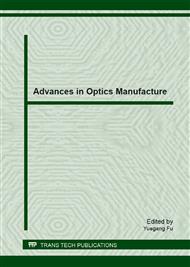p.329
p.339
p.345
p.349
p.356
p.361
p.367
p.373
p.377
Influence of Laser Scribing System in the Electrical Properties for a-Si Thin Film Solar Cell Preparation
Abstract:
Laser scribing of hydrogenated amorphous silicon (a-Si) is a crucial step in the fabrication of thin film photovoltaic modules. The required line width of the laser scribing process for a-Si thin film solar cell preparation is 30 m~50 m, the dead zone is less than 300 m in size, and the line depth should be compliant with the process requirements. Thus, the high imaging quality and focal depth of the optical system is required in the laser scribing system. Three crucial laser patterning steps (known as P1, P2 and P3 in the photovoltaic literature) are integrated in the thin film silicon module manufacturing sequence. Therefore, efforts to optimize these laser processes are demanded by the photovoltaic industry. In particular, the state of the remaining material after laser treatment is known to have a critical influence on the electrical properties of the final devices. This paper focuses on the P3 laser scribing process with the peculiarity that it has been done in single solar cells. By evaluating it in single solar cells rather than in finished module, it is possible to isolate its effect on the device characteristics since the P1 and P2 scribings are omitted. To study the effect of the P3 scribing length, several scribings can be done in the same cell. As it will be shown, the high speed motion systems needed for precision laser scribing plays an important role in this experiment. They can be responsible for the electrical losses after the scribing of the solar cells. If this is dealt with properly, it can be seen that the P3 scribings have very little effect on the electrical characteristics of the processed solar cells.
Info:
Periodical:
Pages:
356-360
Citation:
Online since:
May 2013
Authors:
Price:
Сopyright:
© 2013 Trans Tech Publications Ltd. All Rights Reserved
Share:
Citation:



